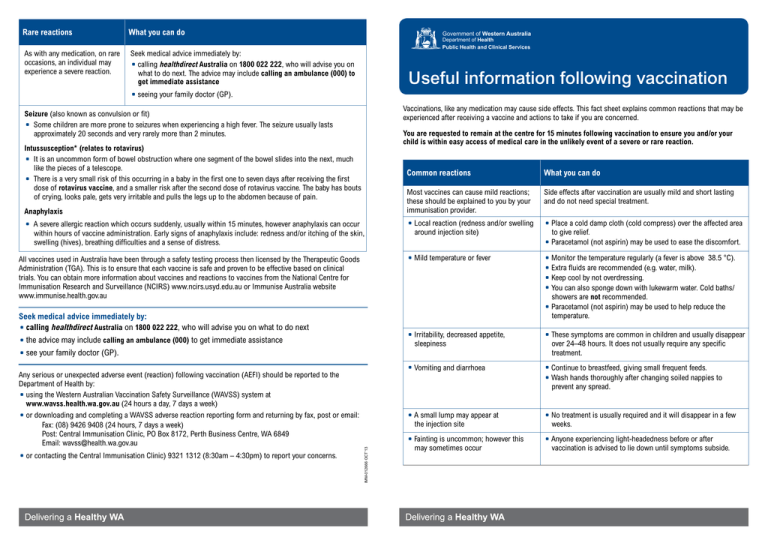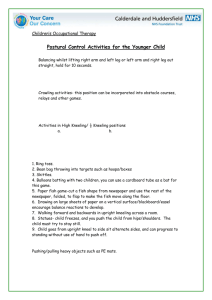Useful information following vaccination (PDF 190KB)
advertisement

Rare reactions What you can do As with any medication, on rare occasions, an individual may experience a severe reaction. Seek medical advice immediately by: **calling healthdirect Australia on 1800 022 222, who will advise you on what to do next. The advice may include calling an ambulance (000) to get immediate assistance **seeing Government of Western Australia Department of Health Public Health and Clinical Services Useful information following vaccination your family doctor (GP). Vaccinations, like any medication may cause side effects. This fact sheet explains common reactions that may be experienced after receiving a vaccine and actions to take if you are concerned. Seizure (also known as convulsion or fit) ** Some children are more prone to seizures when experiencing a high fever. The seizure usually lasts approximately 20 seconds and very rarely more than 2 minutes. You are requested to remain at the centre for 15 minutes following vaccination to ensure you and/or your child is within easy access of medical care in the unlikely event of a severe or rare reaction. Intussusception* (relates to rotavirus) ** It is an uncommon form of bowel obstruction where one segment of the bowel slides into the next, much like the pieces of a telescope. ** There is a very small risk of this occurring in a baby in the first one to seven days after receiving the first dose of rotavirus vaccine, and a smaller risk after the second dose of rotavirus vaccine. The baby has bouts of crying, looks pale, gets very irritable and pulls the legs up to the abdomen because of pain. Anaphylaxis ** A severe allergic reaction which occurs suddenly, usually within 15 minutes, however anaphylaxis can occur within hours of vaccine administration. Early signs of anaphylaxis include: redness and/or itching of the skin, swelling (hives), breathing difficulties and a sense of distress. All vaccines used in Australia have been through a safety testing process then licensed by the Therapeutic Goods Administration (TGA). This is to ensure that each vaccine is safe and proven to be effective based on clinical trials. You can obtain more information about vaccines and reactions to vaccines from the National Centre for Immunisation Research and Surveillance (NCIRS) www.ncirs.usyd.edu.au or Immunise Australia website www.immunise.health.gov.au ** see your family doctor (GP). Any serious or unexpected adverse event (reaction) following vaccination (AEFI) should be reported to the Department of Health by: **using the Western Australian Vaccination Safety Surveillance (WAVSS) system at www.wavss.health.wa.gov.au (24 hours a day, 7 days a week) **or downloading and completing a WAVSS adverse reaction reporting form and returning by fax, post or email: Fax: (08) 9426 9408 (24 hours, 7 days a week) Post: Central Immunisation Clinic, PO Box 8172, Perth Business Centre, WA 6849 Email: wavss@health.wa.gov.au **or contacting the Central Immunisation Clinic) 9321 1312 (8:30am – 4:30pm) to report your concerns. Most vaccines can cause mild reactions; these should be explained to you by your immunisation provider. Side effects after vaccination are usually mild and short lasting and do not need special treatment. **Local reaction (redness and/or swelling around injection site) **Place **Mild **Monitor temperature or fever **Irritability, sleepiness **Vomiting a cold damp cloth (cold compress) over the affected area to give relief. **Paracetamol (not aspirin) may be used to ease the discomfort. the temperature regularly (a fever is above 38.5 °C). fluids are recommended (e.g. water, milk). **Keep cool by not overdressing. **You can also sponge down with lukewarm water. Cold baths/ showers are not recommended. **Paracetamol (not aspirin) may be used to help reduce the temperature. decreased appetite, and diarrhoea **These symptoms are common in children and usually disappear over 24–48 hours. It does not usually require any specific treatment. **Continue to breastfeed, giving small frequent feeds. hands thoroughly after changing soiled nappies to prevent any spread. **Wash small lump may appear at the injection site IMM-012666 OCT’13 the advice may include calling an ambulance (000) to get immediate assistance What you can do **Extra Seek medical advice immediately by: **calling healthdirect Australia on 1800 022 222, who will advise you on what to do next ** Common reactions **A **No **Fainting **Anyone is uncommon; however this may sometimes occur treatment is usually required and it will disappear in a few weeks. experiencing light-headedness before or after vaccination is advised to lie down until symptoms subside. First name: Last name: Site Disease and vaccine Left Right Oral (by mouth) Rotavirus Rotateq Other arm arm Pneumococcal conjugated vaccine leg leg Prevenar 13 Vaccine-specific side effects **Mild temperature **Vomiting and diarrhoea can occur up to 7 days after vaccination **Vaccine virus can be shed in the stools, particularly after the first dose. Handwashing is important after nappy changes. **Intussusception* – see ‘rare reactions’ leg leg arm arm leg leg arm arm leg leg arm arm leg leg arm arm leg leg arm arm leg leg Diphtheria/tetanus/ pertussis containing vaccines Infanrix Hexa (+Polio, Hib, Hep B) Quadracel (+Polio) Adacel Other Given at 2,4,6 months **Mild Haemophilus influenza type b (Hib) **See temperature **Irritable, crying, generally unsettled **Drowsiness or tiredness ‘common reactions’ Hiberix Other Human papillomavirus Gardasil Other **See Meningococcal C Neisvac-C Other **See ‘common reactions’ headache **Mild nausea **Mild ‘common reactions’ crying, unsettled and generally unhappy **Loss of appetite **Headache (older children/adults) **Irritable, Measles/mumps/rubella The following reactions may occur 5–12 days after vaccination: **High fever over 39 °C lasting 2–3 days Priorix **Faint red rash (not infectious) MMR II **Runny nose, cough and/or puffy eyes Other **Swelling of salivary glands **Drowsiness or tiredness **Thrombocytopenia (low platelet count – about 1 in 30,000), and Encephalitis (inflammation of the brain – about 1 in 3 million) are two very rare reactions Hib-MenCCV Menitorix Other arm arm leg leg arm arm leg leg arm arm leg leg arm arm leg leg arm arm leg leg arm arm leg leg arm arm leg leg Varicella (chickenpox) Varilrix Other temperature **Pain at the injection site Given at 2,4,6 months arm Site Disease and vaccine Left Right **Mild Other arm Date vaccines received: **See ‘common reactions’ **Loss of appetite Measles/mumps/ rubella/varicella Priorix-Tetra ProQuad Other Vaccine-specific side effects **See ‘common reactions’ **High fever over 39 °C The following reactions may occur 5–26 days after vaccination: **Mild chickenpox-like rash (2–5 spots) usually at injection site, may also appear on other parts of the body If those vaccinated develop a rash, they should cover the rash and avoid contact with people who have impaired immunity for the duration of the rash. **See ‘common reactions’ The following reactions may occur 5–26 days after vaccination: **High fever over 39 °C lasting 2–3 days **Faint red rash (not infectious) **Runny nose, cough and/or puffy eyes **Swelling of salivary glands **Drowsiness or tiredness **Mild chickenpox-like rash (2–5 spots) usually at injection site may also appear on other parts of the body If those vaccinated develop a rash, they should cover the rash and avoid contact with people who have impaired immunity for the duration of the rash. Hepatitis B HB Vax II (adult) HB Vax II (paediatric) Other **See Pneumococcal polysaccharide vaccine Pneumovax 23 Other **See Influenza Vaxigrip Vaxigrip Junior Influvac Fluvax Fluarix Other **See Hepatitis A Vaqta other **See Polio IPOL Other **See ‘common reactions’ sweating, muscle pain, insomnia and earache **Dizziness, ‘common reactions’ pain **Muscle ‘common reactions’ or tiredness **Muscle aches **Gillian-Barre Syndrome (ascending paralysis) Very rare in adults (1 in 1,000,000) **Drowsiness ‘common reactions’ **Rash ‘common reactions’
